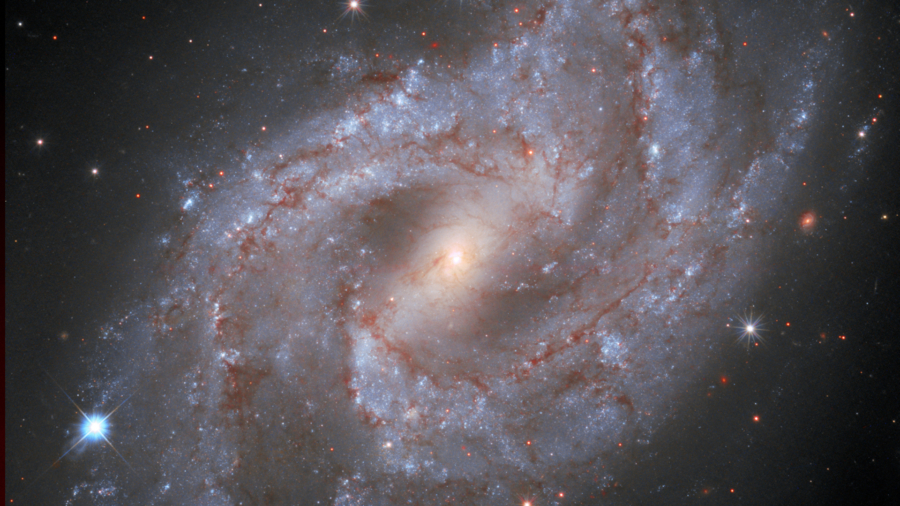The Hubble Space Telescope has served as a spectacular set of eyes on the universe for more than 30 years, looking into the past and witnessing the life cycle of stars and galaxies.
Given the vastness of the universe and its wealth of countless stars, Hubble has captured its share of supernova images. It’s estimated that stars explode at a rate of one per second across the universe.
But actually observing the brilliance of a supernova as it fades away into oblivion is more rare. And now, Hubble has essentially captured a time-lapse movie of this event.
Hubble in February 2018 began observing a supernova that was detected just a few weeks earlier by amateur astronomer Koichi Itagaki. The supernova, dubbed SN 2018gv, was spotted in a spiral galaxy 70 million light-years away. That means it has taken 70 million years for the light from this event to reach us, so we’re actually witnessing a supernova from the distant past.
The supernova released as much energy in days as our sun does over the timescale of several billion years, or the radiance from 5 billion suns. The light from the explosion was even brighter than that of its host galaxy and the most radiant stars in the galaxy.
It occurred after a white dwarf, or dead star, pulled material away from its companion star. This caused an excess of gas that served as the ignition for a thermonuclear explosion and effectively turning the white dwarf into an atomic bomb.
Then, astronomers watched as the supernova faded away into nothing over nearly a year. Hubble released a new time-lapse video Thursday that compresses this into a few seconds.
“No Earthly fireworks display can compete with this supernova, captured in its fading glory by the Hubble Space Telescope,” said Nobel Laureate Adam Riess in a statement. Riess is a professor of astronomy and physics at Johns Hopkins University and a senior member of the science staff at the Space Telescope Science Institute, both in Baltimore.
The detection of the universe’s expansion rate, aided by Hubble, helped lead to the 2011 Nobel Prize in Physics, awarded to Riess, Saul Perlmutter and Brian P. Schmidt “for the discovery of the accelerating expansion of the universe through observations of distant supernovae.”
Hubble astronomers observed the supernova as it faded—in part to provide more data for a program that measures the expansion rate of the universe. Supernovae can help astronomers measure the distances to galaxies, acting like mile markers for the rate at which galaxies speed away from each other. This can help provide a way to estimate the age of the universe as well.
Supernovae like this one peak at the same brightness, which makes them “standard candles” for astronomers wanting to calculate the distance to the galaxies hosting these exploding stars.
This observation is one of many that have helped astronomers refine the universe’s rate of expansion since Hubble launched in 1990. The telescope was expected to last for 15 years, and it’s still going strong. But Hubble was also designed to be serviced and upgraded over time—in space.
Hubble Maintenance in Space
Between December 1993 and May 2009, astronauts launched on the space shuttle and rendezvoused with the telescope to make repairs and replace gyroscopes and instruments. The first mission, in 1993, helped fix Hubble’s infamous mirror flaw that was causing blurry images to be returned by the telescope. Astronauts installed corrective optics and new instruments to fix it.
Each mission, which took years of planning and preparation, required the astronauts to leave the shuttle and conduct spacewalks to and inside a component of the telescope for repairs and installing instruments. All while the telescope moved at 17,000 miles per hour at an inclined 28.5 degrees to the equator around the Earth.
Mike Massimino was one of the NASA astronauts who worked on two of these servicing missions, including the final one in 2009.

Hubble launched when he was in grad school, and when he was selected to work on the servicing missions, Massimino called it “the highlight of my professional career.”
Massimino said there was a mutual respect between the scientists and the astronauts. The scientists appreciated that the astronauts could help repair and upgrade the telescope to be used for years to come, and the astronauts appreciated the opportunity to go on spacewalks to service Hubble.
“It was a spacewalker’s dream, and to be involved with something where the benefit was so clear,” Massimino told CNN this week. “If we did our job, astronomers would be given this great opportunity to share Hubble’s science with the world and the beauty of the universe. Hubble is this great combination of what engineering and science can do together.”


